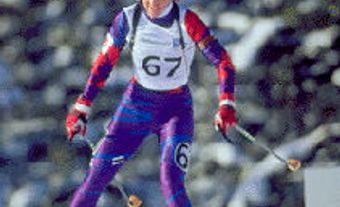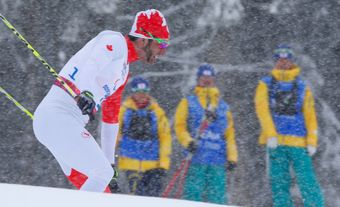In 1975, alpine skier Ken Read became the first North American to win a World Cup downhill race. For a period of about ten years, Read and three other young Canadians — Dave Irwin, Dave Murray, and Steve Podborski — challenged the European ski establishment and changed the course of ski racing history in Canada. From 1974 to 1984 the four “Crazy Canucks” won a total of 39 World Cup podiums (including 14 first place finishes), one World Cup Downhill Title, and an Olympic bronze medal. Their success would inspire the national ski program and succeeding generations of alpine racers.
Editorial Note: Like the four Crazy Canucks, Canadian alpine skiers Jim Hunter and Todd Brooker enjoyed marked success on the World Cup circuit in the 1970s and 1980s; although both are often linked to the Crazy Canucks, their stories are addressed in separate articles (article on Jim Hunter forthcoming).
The Members
“It would be hard to find a more disparate collection of personalities.” (Podborski, circa 1998)
Dave Murray, the spiritual loner who loved to strum his guitar, grew up skiing on Whistler Mountain in British Columbia.
Dave Irwin, with a super-competitive streak and known as “Thunder Thighs”, learned to ski on Loch Lomond, the ski area his father Bill developed in Thunder Bay, Ontario.
Steve Podborski, the youngest on the team, had sheer guts. He grew up skiing at the Craigleith Ski Club near Collingwood, Ontario.
Ken Read, intensely focused with a steely-eyed determination, first started skiing on the mountains near Vancouver before his family moved east and he joined the Ottawa Ski Club at Camp Fortune.
First International Victories
The two Daves moved up to the World Cup circuit in the fall of 1973; Read and Podborski joined them the following year. Then, on 7 December 1975, the Canucks introduced a new era to the downhill skiing world and European ski establishment. On that day Read won the first men’s World Cup downhill race of the season in Val d’Isere, France. He became the first North American male to stand on top of the podium at a World Cup downhill race.
Two weeks later, on 20 December 1975, Irwin won on the Planai course at Schladming, Austria. It was at Schladming in 1973 that Franz Klammer, one of the greatest downhill racers of all time, won his first ever World Cup downhill race. But in 1975 Irwin blew the Austrian ski hero away and beat 52 of the world’s best racers to record Canada’s second downhill victory.
Twenty-five years later, Klammer remarked: “If it weren’t for the Canadians, I would have won more races!”
The Canadians had become serious contenders.
The Canucks brought a new dynamic to the World Cup circuit. French fans felt that if a Frenchman couldn’t win, they were happy to have a Canadian win. It was certainly better than having an old rival like Austria or Italy stand on the podium.
Shortly after he retired, Dave Murray commented on the phenomenon: “The Europeans could be fans of ours without compromising their nationality. The Austrians couldn’t cheer for the Swiss, and the Italians couldn’t cheer for the Germans, but they could all cheer for us.”
Years later, around 1996, Irwin recalled the crowds of fans waiting for them after races:
“We were known for standing at the finish line and not leaving until everyone had their autographs signed. I remember when Dave Murray and I were signing autographs at Val Gardena (Italy), when there were only around ten kids left, I looked up and the whole area was empty, even the van was gone. We signed the last ones and then we had to walk up the road and hitchhike back to town. But all the little kids were taken care of.”
Those “Crazy Canucks”
Newspapers and spectators talked of their daring courage and all-out efforts on the dangerous and fast courses. Articles about the “Kamikaze Canadians” headed many sports pages in Europe. Serge Lang (journalist and co-founder of the Alpine Ski World Cup in 1966) wrote of the boldness and aggressiveness of these young racers from Canada.
It was Lang who first coined the term “Crazy Canuck,” in response to a spectacular run by Irwin at Wengen, Switzerland, on 9 January 1976.
“I slipped on my side, got my feet the other way, slipped on the other side, put both feet up against the hay bales, skied along for twenty-thirty feet, got one foot back on the snow, rocketed across to the other side of the track, ran over a cameraman and went through the finish. It looked spectacular. I placed eighteenth. Mr Lang, a huge, burly man, looked down at me and shook his head saying, ‘Crazy Canuck’. And that’s the first time I heard those words spoken.” (Dave Irwin, circa 1996)
But the following day, 10 January 1976, Irwin had a devastating crash on the same course. Going into the second race Irwin was one of the top downhillers in the world. Coming out of the race he was lucky to be alive.
Irwin fell on the course, where moments before Read had also crashed and walked away unharmed. But at 120 km/h (75 mph), Irwin’s body launched into mid-air and then landed hard on his upper back. He bounced down the course until he finally slid to a stop in the protective net.
Every piece of his equipment was broken: both skis, both poles and his helmet were shattered. Dr. Courtney Brown of the US Ski Team was the first doctor to reach him. Within minutes a helicopter arrived and Brown accompanied him on the 13-minute flight to the hospital in Interlaken. The news was grim. Irwin had suffered a severe concussion, broken ribs, facial cuts and abrasions caused by his broken eyeglasses. He passed in and out of consciousness for three days and remained in hospital for a week. Three weeks later, he placed eighth at the 1976 Olympic Winter Games in Innsbruck, Austria.
In the following two seasons the Canucks faced not only injuries, but also equipment challenges, coaching changes, media pressure, and political challenges (at home and on the circuit). However, they continued to rise with determination and courage. On 11 February 1978, Read finished first and Murray second at Les Houches, France, in what was Canada’s first one-two result.
Masters of the Hahnenkamm
For four consecutive years (1980–1983) Canadian skiers won the Hahnenkamm at Kitzbuehel, Austria (Read 1980, Podborski 1981–2, and Todd Brooker 1983). Its long vertical drop over the steep sections has given it a reputation as the world’s toughest downhill. The icy terrain demands exceptional skill.
Sportscaster Brian Williams described the Canucks’ love for the spot: “At Kitzbuehel the Canucks liked the danger. It’s the Masters. It’s skiing’s answer to the Kentucky Derby, it’s the big race. It’s the most dangerous, it’s exempt from safety regulations. It’s too narrow, it’s too steep, it’s too icy. And the Canadians love this. This is what added to their lore. This is what added to their mystique. This is what the Europeans loved, that these Canadians came over, on a course that most Europeans feared, and they seemed to enjoy this course.”
For downhill racers, winning the Hahnenkamm is the Super Bowl of downhills; the fact that Canadians won for four consecutive years is a truly remarkable feat.
The 1980 Lake Placid Olympic Winter Games
The Canucks went into the 1980 Olympic Winter Games at Lake Placid as strong medal contenders. Canada’s Crazy Canucks were veterans by this point and accustomed to the pressures of international racing.
Canadians were expecting a medal in the downhill, and although Read was the favourite, any one of the Canucks could have done it. The pressure was on to bring home a medal to Canada.
On race day, visibility was limited on snowy, high Whiteface. Podborski, with a 15th start position, skied to a bronze medal to win Canada’s first Olympic medal in men’s alpine skiing. He shared the podium with two Austrians: Leonard Stock (gold) and Peter Wirnsberger (silver).
The World Cup Downhill Title and Retirement
On 6 March 1982, on Ruthie’s Run, Ajax Mountain in Aspen, Colorado, the Crazy Canucks raced together for the last time. It was also the same day 24-year-old Podborski became the first North American male to win the World Cup downhill title.
Murray and Irwin retired from competitive skiing and moved on to new chapters in their lives. Read retired a year later in 1983 and Podborski in 1984. The Crazy Canuck era was over.
A Canadian Sports Legacy
The Crazy Canucks’ precarious style, discipline, self-motivation and passion proved to be a turning point for men’s alpine skiing in Canada. From 1974 to 1984 the four Canucks won a total of 39 World Cup podiums (including 14 first place finishes.), one World Cup Downhill Title, and an Olympic bronze medal. Their success would inspire the national ski program and succeeding generations of alpine racers.
When Steve Podborski skied his last downhill race on 11 March 1984 on Whistler Mountain, BC, another Canadian, Rob Boyd, was racing in his first World Cup. Five years later on the same course, Boyd became the first Canadian male to win a World Cup downhill race in Canada.
To young Canadians, the Crazy Canucks proved that the Europeans could be beaten. They were an inspiration for others who would follow, including Chris Kent, Todd Brooker, Felix Belczyk, Edi Podivinsky and many more.
According to John Kucera, the first Canadian to win the men’s downhill at the World Championships (2009), alpine skiers in Canada owe a great deal to the Canucks:
“When you look at what the Crazy Canucks did to put ski racing on the map in the 1970s and '80s, they're probably one of the biggest reasons we have accomplished what we have to date.” (John Kucera, 2013)
Note: Quote from David Murray taken from Murray’s personal papers, courtesy of Stephanie Sloan. Quote from John Kucera from the website of the Canadian Sport Institute Calgary. All other quotes were obtained by the author through interviews undertaken for the book The Crazy Canucks: Canada’s Legendary Ski Team (2008).

 Share on Facebook
Share on Facebook Share on X
Share on X Share by Email
Share by Email Share on Google Classroom
Share on Google Classroom


